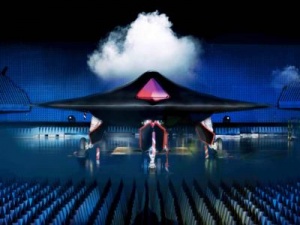 Taranis: an armed flying sauce for the 21st century
July 12, 2010 will go down in the annals of military history as the day aerial warfare changed forever. That’s the day BAE, a UK based company, rolled out Taranis. BAE is the same company that invented the Harrier, the first jet aircraft to take off and land vertically. The new ship is a stealth bomber, fighter, intelligence gatherer: an Unmanned Combat Aircraft Systems, (UCAS) with the capabilities of manned fighters and bombers without a crew on board.
Development began in 2006 under contract with the British Ministry of Intelligence. BAE brought in Rolls Royce, among other British companies in a joint design effort of the unmanned fighter/bomber. Taranis, originally scheduled to cost 123 million pounds, now has a price tag of 145 million pounds- and it hasn’t flown yet. Ground testing has begun and aerial testing is scheduled for 2011.
BAE’s website says that “Taranis will explore and demonstrate how emerging technologies and systems can deliver battle-winning capabilities for the UK Armed Forces incorporating both an autonomous and survivable UAV concept design. Any future in-service systems based on such a concept design will be under the command of highly skilled ground based operators who will also be able to remotely pilot the aircraft.
The purpose of the vehicle is to inform the Brit military of how manned and unmanned aircraft can be used on a modern battlefield. The use and expansion of unmanned aircraft and their relationship to piloted craft is being debated in every country that can afford an air force. The US began using unmanned drones in both Iraq and Afghanistan early in both wars. The CIA was an early adopter; using drones to “take out” (kill) leaders of Al Qaida and the Taliban.
The reasons for using unmanned craft are related to cost and practicality. It’s very expensive to buy manned fighters. F-16s cost about fifteen million dollars. European fighters can cost upward of 100 million dollars. Training pilots is also an expensive and time consuming proposition- about 2.5 million dollars each in the US and 6 million pounds in the UK.
It’s so much cheaper to train computer savvy youngsters who already know their way around a joystick to guide a fighter thousands of miles away by satellite uplink. No crew losses. No pilots. No families. No objections on the homefront when war is fought by remote control.
The US military may be thinking about expanding the drone program to include UCAS, but they will be playing catch up with the Brits. History will show that Taranis will change military force equations and tactics for a very long time to come. It may even reinforce the way the Western world views of warfare – as a bloodless video game being played somewhere far away.
For more on Taranis, visit the BAE website:
http://www.baesystems.com/Sites/Taranis/index.htm
|







